A Study on the Influence of Stage Load on Health Monitoring of Axial Concrete Members Using Piezoelectric Based Smart Aggregate
Abstract
:Featured Application
Abstract
1. Introduction
2. The Principle of Active Monitoring
3. Experimental Investigation
3.1. Concrete Mix Design and Specimens
3.2. Test Method
4. Results and Discussion
4.1. Amplitude Analysis
4.2. Velocity Analysis
5. Conclusions
- Wave velocity shows an increasing trend before a sharp decline at high stress level. It is possible to use wave velocity for stress evaluation of concrete structures that are subjected to monotonic axial compressive load in elastic phase.
- The influence of step load on amplitudes of sensing signals is not monotonous. Although previous study recommend that the amplitude of signals can be taken as an index to describe the strength development of early age concrete, this method may be invalid in in-situ monitoring strength development of early age concrete in columns of lower floors during construction stage.
- For further research, tests with more concrete mixtures and larger amounts and scales of specimens need to be conducted.
Acknowledgments
Author Contributions
Conflicts of Interest
References
- Cabeza, M.; Merino, P.; Nóvoa, X.R.; Sánchez, I. Electrical effects generated by mechanical loading of hardened Portland cement paste. Cem. Concr. Compos. 2003, 25, 351–356. [Google Scholar] [CrossRef]
- Díaz, B.; Nóvoa, X.R.; Pérez, M.C. Study of the chloride diffusion in mortar: A new method of determining diffusion coefficients based on impedance measurements. Cem. Concr. Compos. 2006, 28, 237–245. [Google Scholar] [CrossRef]
- Sánchez, I.; Antón, C.; de Vera, G.; Ortega, J.M.; Climent, M.A. Moisture Distribution in Partially Saturated Concrete Studied by Impedance Spectroscopy. J. Nondestruct. Eval. 2013, 32, 362–371. [Google Scholar] [CrossRef] [Green Version]
- International Union of Laboratories and Experts in Construction Materials, Systems and Structures (RILEM). RILEM Report 40 Non-Destructive Evaluation of the Penetrability and Thickness of the Concrete Cover; RILEM: Bagneux, France, 2007. [Google Scholar]
- Williams, M.; Ortega, J.M.; Sánchez, I.; Cabeza, M.; Climent, M.Á. Non-Destructive Study of the Microstructural Effects of Sodium and Magnesium Sulfate Attack on Mortars Containing Silica Fume Using Impedance Spectroscopy. Appl. Sci. 2017, 7, 648. [Google Scholar] [CrossRef]
- Ou, J.; Li, H. Structural health monitoring in mainland China: Review and future trends. Struct. Health Monit. 2010, 9, 219–231. [Google Scholar] [CrossRef]
- Sohn, H.; Farrar, C.R.; Hemez, F.M.; Shunk, D.D.; Stinemates, D.W.; Nadler, B.R.; Czarnecki, J.J. A review of structural health monitoring literature: 1996–2001. In Los Alamos National Laboratory Report; LA-13976-MS; Los Alamos National Laboratory: Los Alamos, NM, USA, 2004. [Google Scholar]
- Song, G.; Olmi, C.; Gu, H. An overheight vehicle–bridge collision monitoring system using piezoelectric transducers. Smart Mater. Struct. 2007, 16, 462–468. [Google Scholar] [CrossRef]
- Gu, H.; Song, G.; Dhonde, H.; Mo, Y.L.; Yan, S. Concrete early-age strength monitoring using embedded piezoelectric transducers. Smart Mater. Struct. 2006, 15, 1837–1845. [Google Scholar] [CrossRef]
- Kim, J.; Kim, J.; Park, S.; Oh, T. Integrating embedded piezoelectric sensors with continuous wavelet transforms for real-time concrete curing strength monitoring. Struct. Infrastruct. Eng. 2015, 11, 897–903. [Google Scholar] [CrossRef]
- Kim, J.; Lee, C.; Park, S.; Koh, K. Real-time strength development monitoring for concrete structures using wired and wireless electro-mechanical impedance techniques. KSCE J. Civ. Eng. 2013, 17, 1432–1436. [Google Scholar] [CrossRef]
- Choi, S.; Tareen, N.; Kim, J.; Park, S.; Park, I. Real-Time Strength Monitoring for Concrete Structures Using EMI Technique Incorporating with Fuzzy Logic. Appl. Sci. 2018, 8, 75. [Google Scholar] [CrossRef]
- Liu, T.; Huang, Y.; Zou, D.; Teng, J.; Li, B. Exploratory study on water seepage monitoring of concrete structures using piezoceramic based smart aggregates. Smart Mater. Struct. 2013, 22, 065002. [Google Scholar] [CrossRef]
- Zou, D.; Liu, T.; Huang, Y.; Zhang, F.; Du, C.; Li, B. Feasibility of water seepage monitoring in concrete with embedded smart aggregates by P-wave travel time measurement. Smart Mater. Struct. 2014, 23, 067003. [Google Scholar] [CrossRef]
- Zou, D.; Liu, T.; Qiao, G.; Huang, Y.; Li, B. A Experimental Study on the Performance of Piezoceramic Based Smart Aggregate in Water Environment. IEEE Sens. J. 2014, 4, 943–944. [Google Scholar] [CrossRef]
- Gu, H.; Moslehy, Y.; Sanders, D.; Song, G.; Mo, Y.L. Multi-functional smart aggregate-based structural health monitoring of circular reinforced concrete columns subjected to seismic excitations. Smart Mater. Struct. 2010, 19, 322–328. [Google Scholar] [CrossRef]
- Moslehy, Y.; Gu, H.; Belarbi, A.; Mo, Y.L.; Song, G. Smart aggregate-based damage detection of circular RC columns under cyclic combined loading. Smart Mater. Struct. 2010, 19, 065021. [Google Scholar] [CrossRef]
- Lillamand, I.; Chaix, J.; Ploix, M.A.; Garnier, V. Acoustoelastic Effect in concrete material under uni-axial compressive loading. Ndt E Int. 2010, 43, 655–660. [Google Scholar] [CrossRef]
- Sohn, H. Effects of environmental and operational variability on structural health monitoring. Philosophical Transactions of the Royal Society. Math. Phys. Eng. Sci. 2007, 365, 539–560. [Google Scholar] [CrossRef] [PubMed]
- Peeters, B.; Maeck, J.; de Roeck, G. Vibration-based damage detection in civil engineering: Excitation sources and temperature effects. Smart Mater. Struct. 2001, 10, 518–527. [Google Scholar] [CrossRef]
- Zou, D.; Liu, T.; Liang, C.; Huang, Y. An experimental investigation on the health monitoring of concrete structures using piezoelectric transducers at various environmental temperatures. J. Intell. Mater. Syst. Struct. 2015, 26, 1028–1034. [Google Scholar] [CrossRef]
- Liu, T.; Zou, D.; Du, C.; Wang, Y. Influence of Axial Loads on the Health Monitoring of Concrete Structures Using Embedded Piezoelectric Tranducers. Struct. Health Monit. 2017, 2, 202–214. [Google Scholar] [CrossRef]
- Zou, D.; Liu, T.; Yang, A.; Zhao, Y.; Du, C. A primary study on the performance of piezoceramic based smart aggregate under various compressive stresses. Smart Mater. Struct. 2017, 10, 107003. [Google Scholar] [CrossRef]
- Du, C.; Zou, D.; Liu, T.; Lv, H. An exploratory experimental and 3D numerical investigation on the effect of porosity on wave propagation in cement paste. Measurement 2017. [Google Scholar] [CrossRef]
- Rizzo, P.; Deng, W.; Vandenbossche, J. Detecting the presence of high water-to-cement ratio in concrete surfaces using highly nonlinear solitary waves. Appl. Sci. 2016, 6, 104. [Google Scholar] [CrossRef]
- Nasrollahi, A.; Deng, W.; Rizzo, P.; Vuotto, A.; Vandenbossche, J. Nondestructive testing of concrete using highly nonlinear solitary waves. Nondestruct. Test. Eval. 2017, 32, 381–399. [Google Scholar] [CrossRef]
- Du, C.; Liu, T.; Zou, D.; Teng, J. Time-dependent strain development of early age concrete under step by step load history. Construct. Build. Mater. 2015, 8, 133–139. [Google Scholar] [CrossRef]
- Tsangouri, E.; Karaiskos, G.; Aggelis, D.G.; Deraemaeker, A.; Van Hemelrijck, D. Crack sealing and damage recovery monitoring of a concrete healing system using embedded piezoelectric transducers. Struct. Health Monit. 2015, 9, 462–474. [Google Scholar] [CrossRef]
- Comité Euro-International du Béton (CEB). CEB-FIP Model Code for Concrete Structures; CEB: Lausanne, Switzerland, 1990. [Google Scholar]
- GB/50010-2010. Code for Design of Concrete Structures; Ministry of Housing and Urban-Rural Development of China: Beijing, China, 2010.
- Song, G.; Gu, H.; Mo, Y. Smart aggregates: Multi-functional sensors for concrete structures—A tutorial and a review. Smart Mater. Struct. 2008, 17, 033001. [Google Scholar] [CrossRef]
- Kumar, J.; Madhusudhan, B.N. A note on the measurement of travel times using bender and extender elements. Soil Dyn. Earthq. Eng. 2010, 30, 630–634. [Google Scholar] [CrossRef]
- Wang, L. Foundation of Stress Waves; National Defense Industry Press: Beijing, China, 2010; pp. 178–186. [Google Scholar]
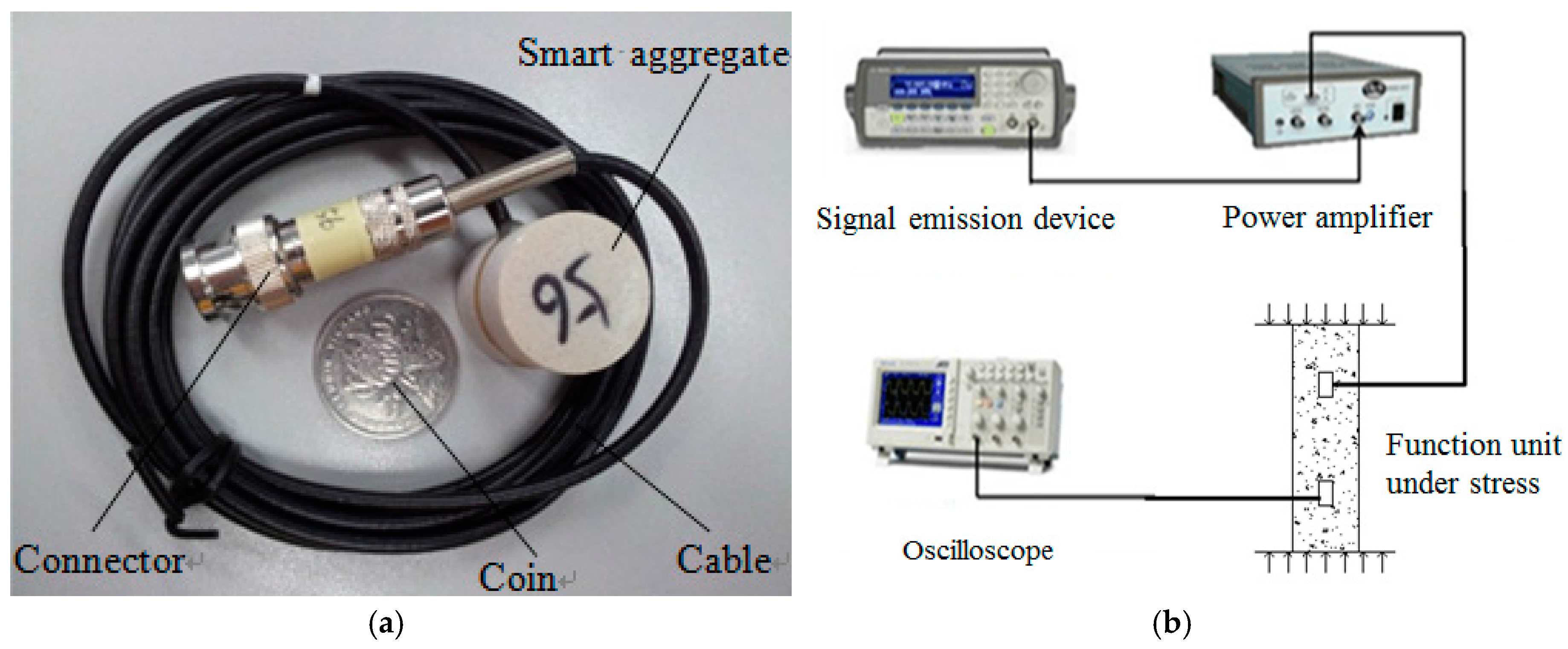
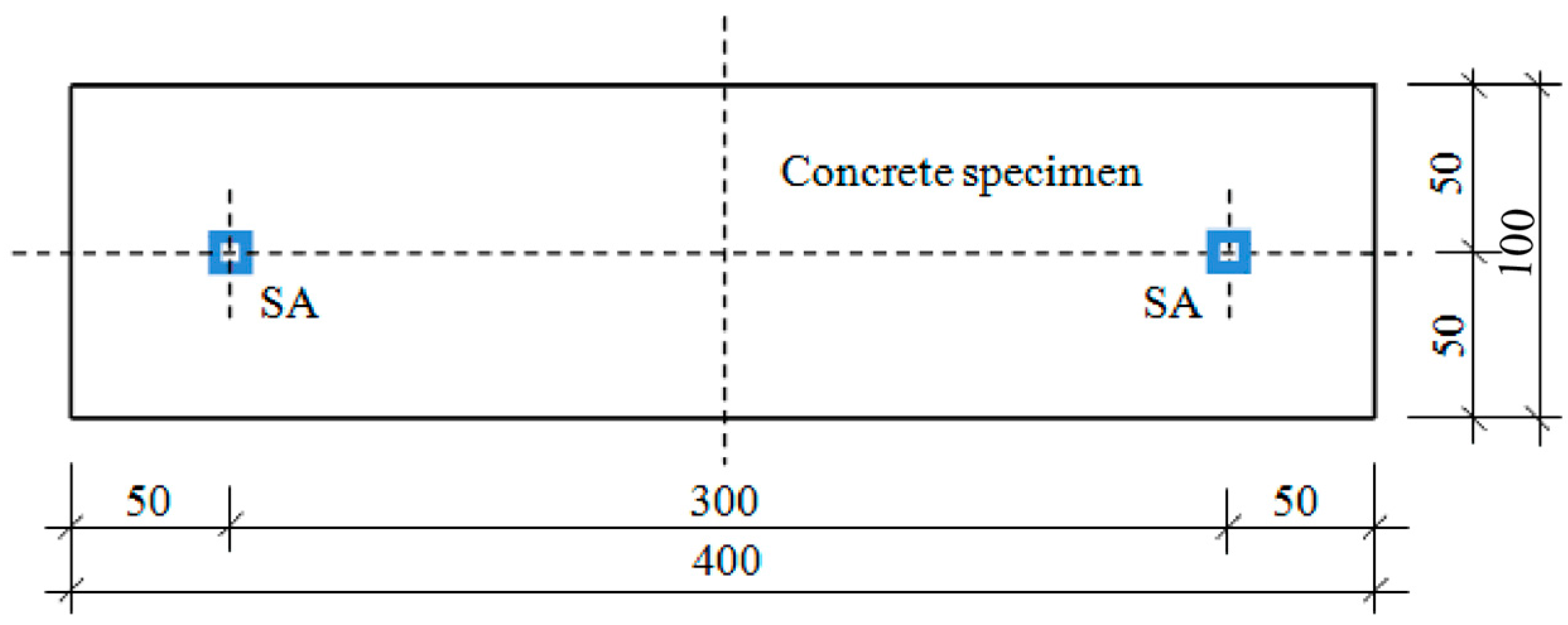

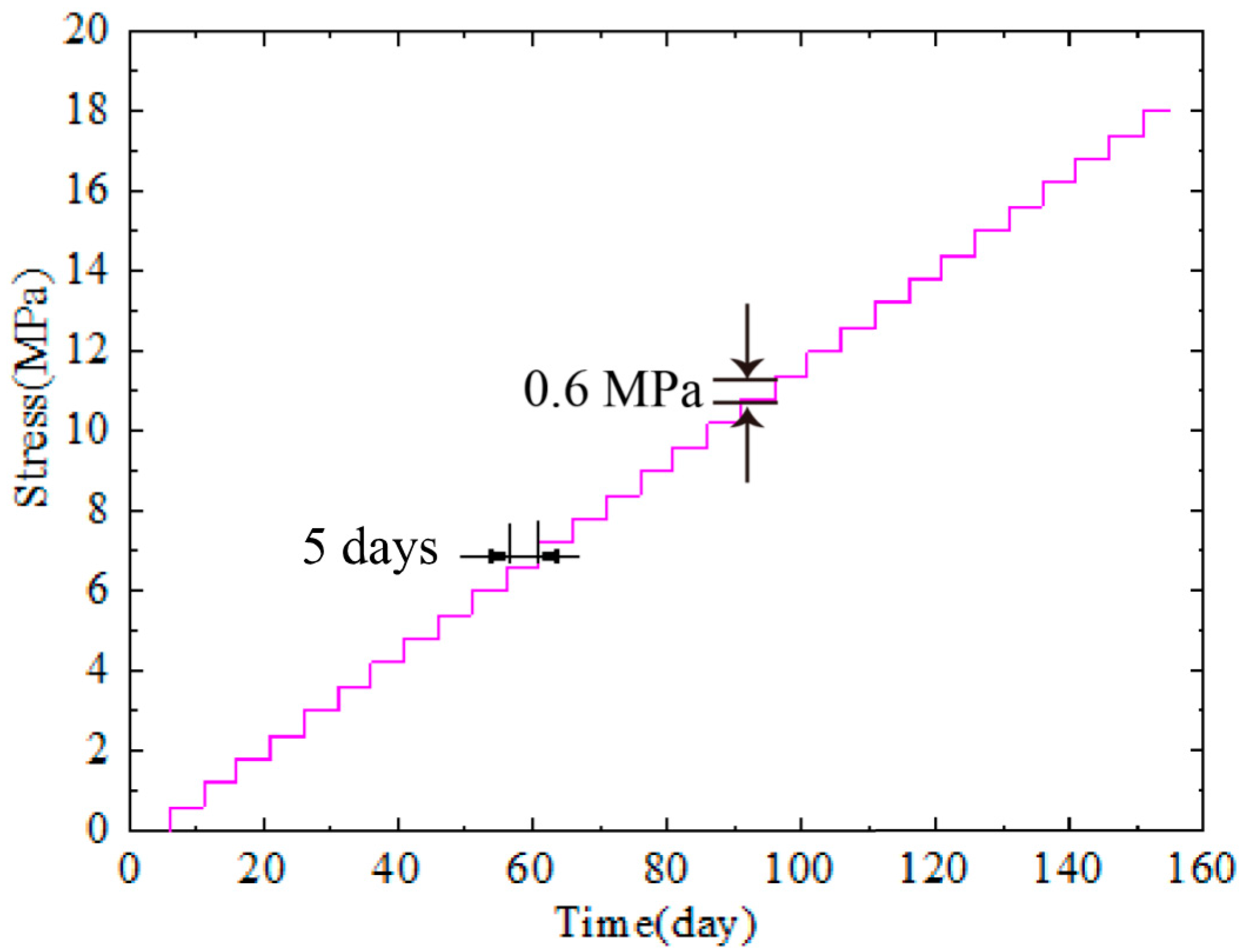
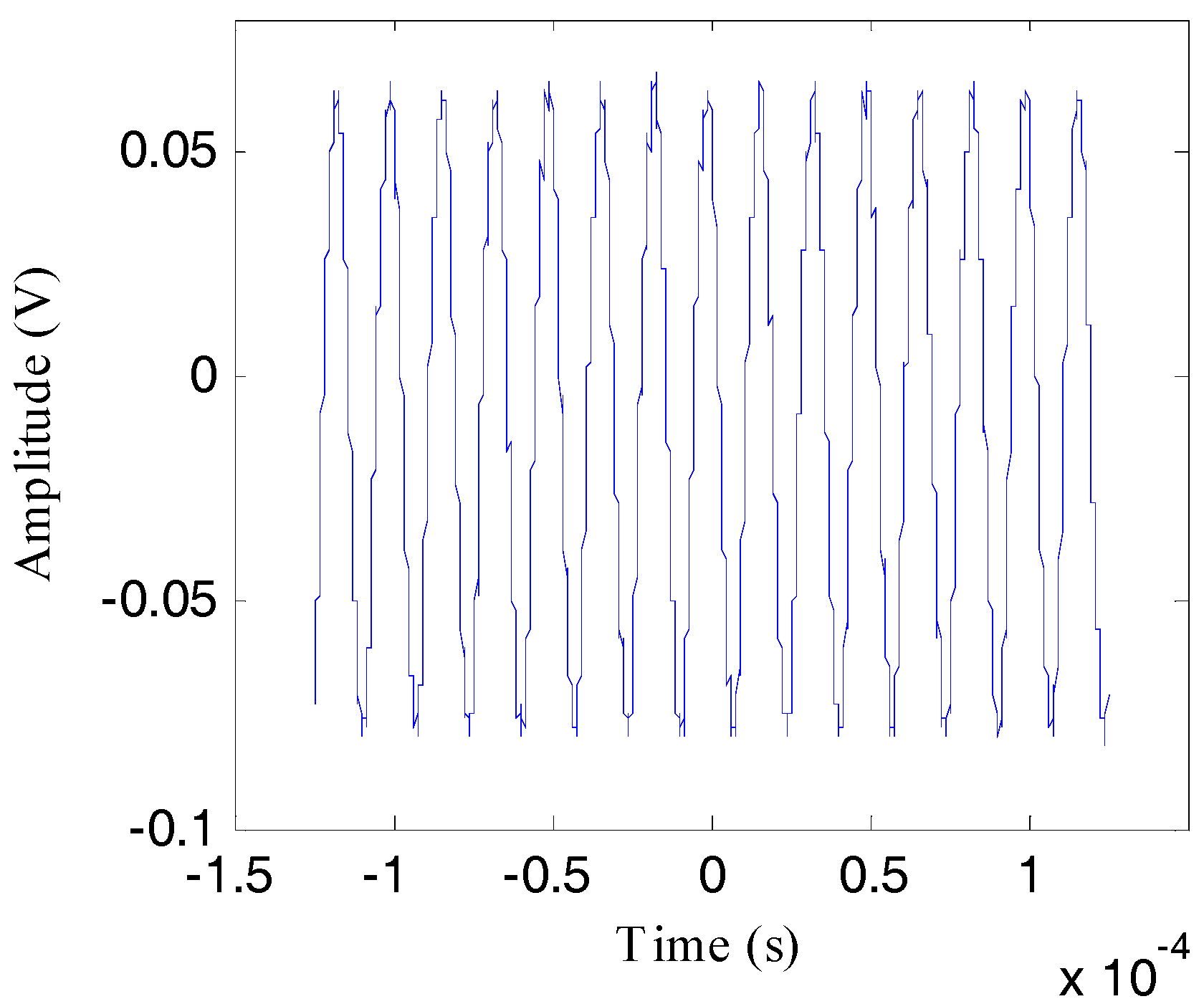

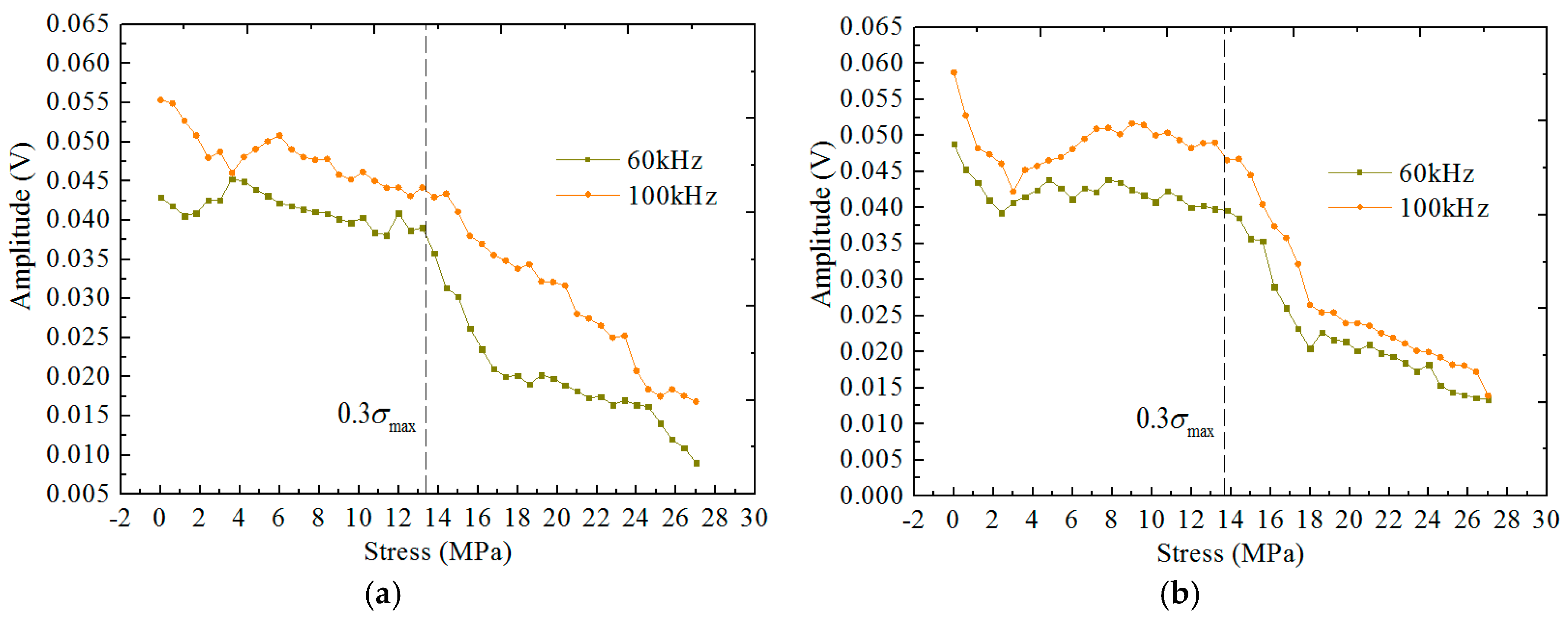
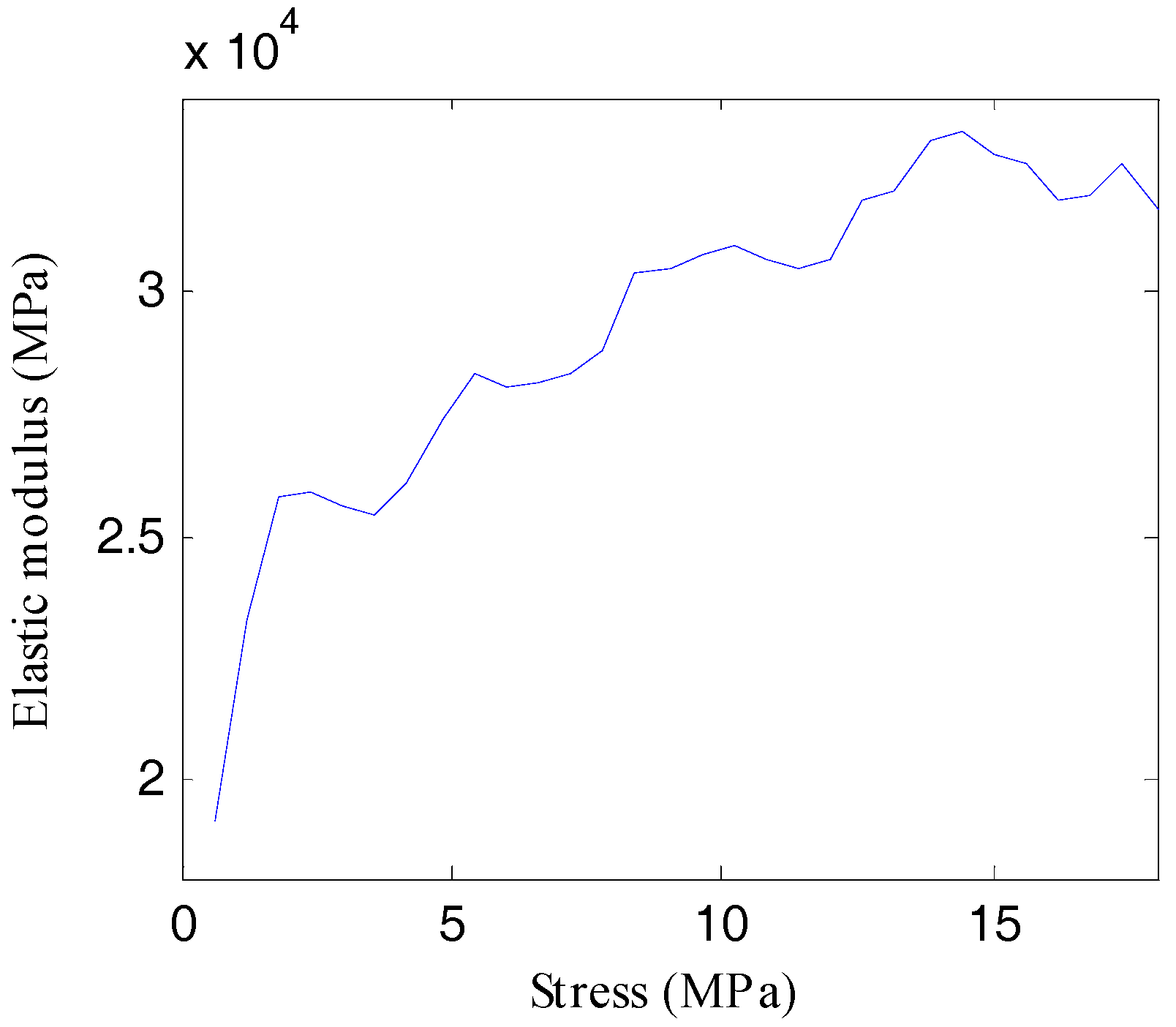
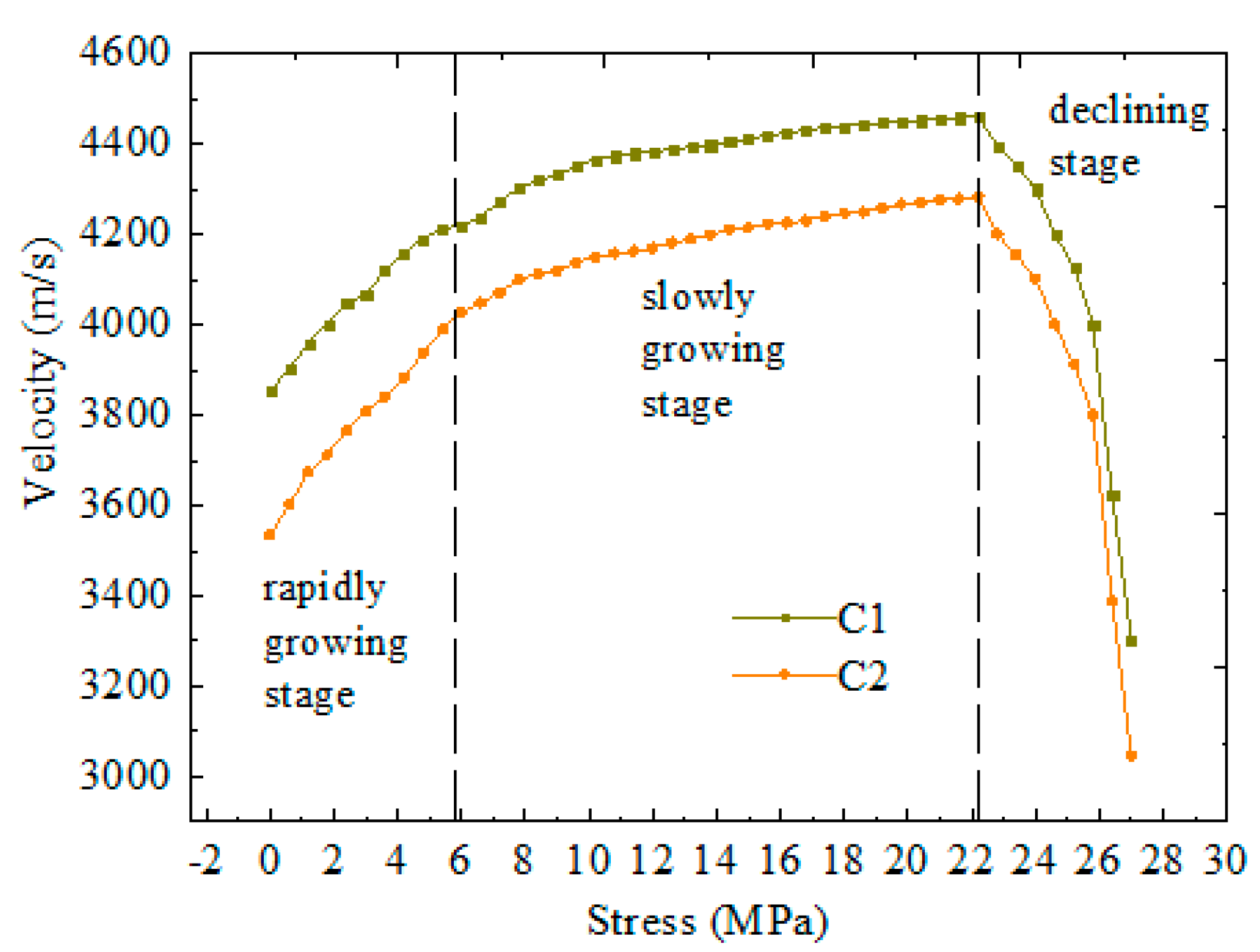
| Component | Weight (kg/m3) | Mix Proportion |
|---|---|---|
| Cement | 300 | 1.00 |
| Water | 160 | 0.53 |
| Sand | 875 | 2.92 |
| Stone | 860 | 2.87 |
| Fly ash | 110 | 0.3667 |
| Slag powder | 80 | 0.2667 |
| Admixture | 4.90 | 1.63% |
| Total | 2390 | -- |
| Specimens | Cubic Compressive Strength (MPa) | ||||
|---|---|---|---|---|---|
| 1 Day | 3 Days | 7 Days | 14 Days | 28 Days | |
| Specimen-1 | 26 | 39.2 | 44.1 | 51.2 | 57.5 |
| Specimen-2 | 27 | 38.1 | 44 | 49.6 | 57.7 |
| Specimen-3 | 25.9 | 39.1 | 45.1 | 49.8 | 58.8 |
| Average | 26.3 | 38.8 | 44.4 | 50.2 | 58 |
© 2018 by the authors. Licensee MDPI, Basel, Switzerland. This article is an open access article distributed under the terms and conditions of the Creative Commons Attribution (CC BY) license (http://creativecommons.org/licenses/by/4.0/).
Share and Cite
Du, C.; Zou, D.; Liu, T.; Li, W. A Study on the Influence of Stage Load on Health Monitoring of Axial Concrete Members Using Piezoelectric Based Smart Aggregate. Appl. Sci. 2018, 8, 423. https://doi.org/10.3390/app8030423
Du C, Zou D, Liu T, Li W. A Study on the Influence of Stage Load on Health Monitoring of Axial Concrete Members Using Piezoelectric Based Smart Aggregate. Applied Sciences. 2018; 8(3):423. https://doi.org/10.3390/app8030423
Chicago/Turabian StyleDu, Chengcheng, Dujian Zou, Tiejun Liu, and Weijie Li. 2018. "A Study on the Influence of Stage Load on Health Monitoring of Axial Concrete Members Using Piezoelectric Based Smart Aggregate" Applied Sciences 8, no. 3: 423. https://doi.org/10.3390/app8030423





